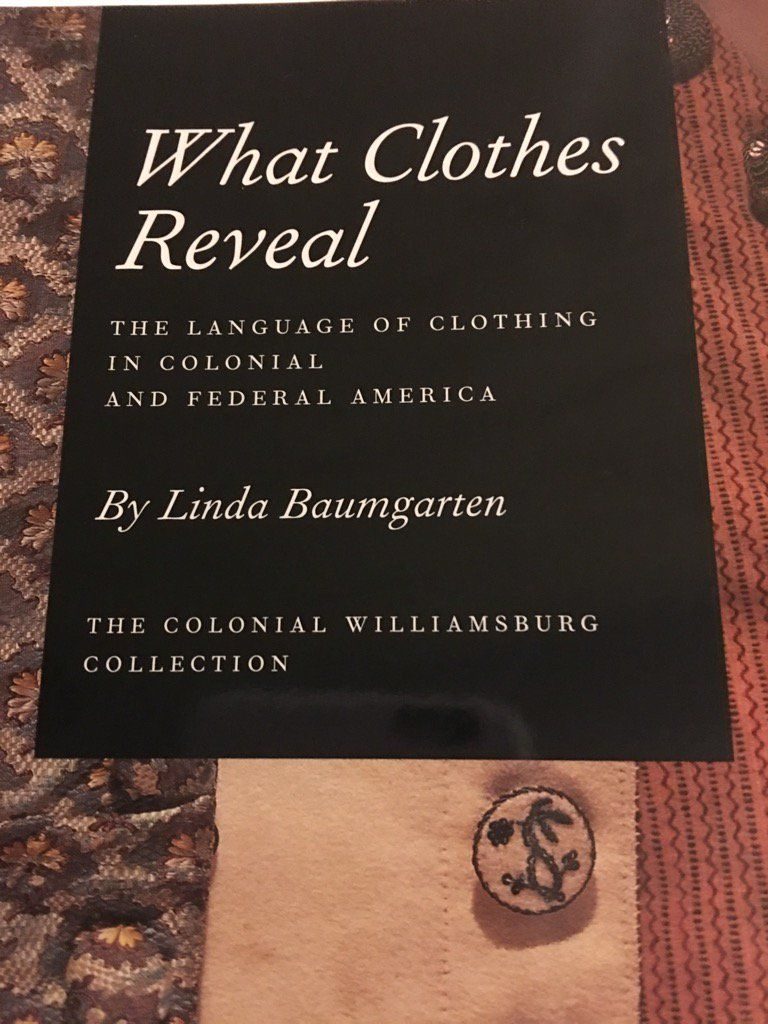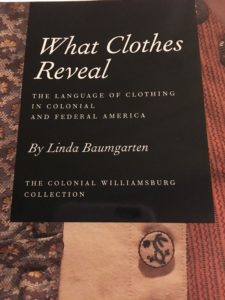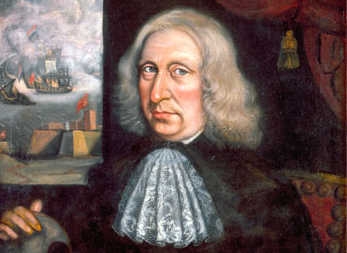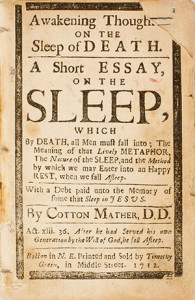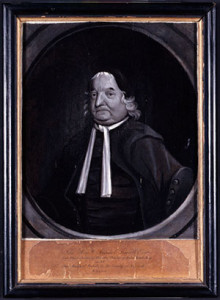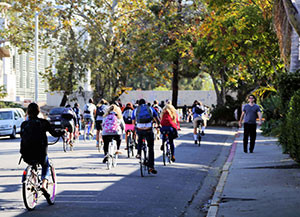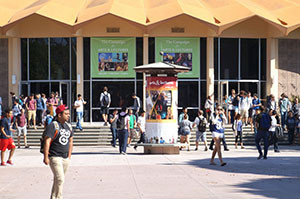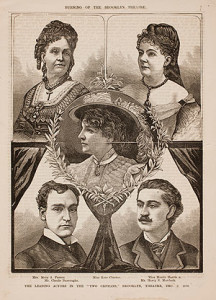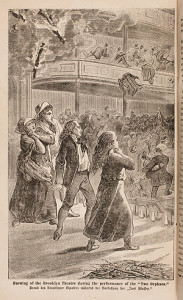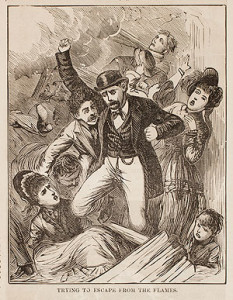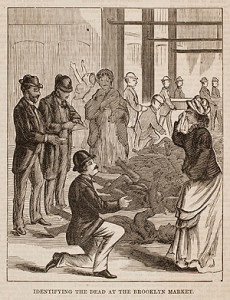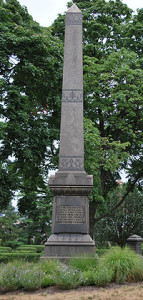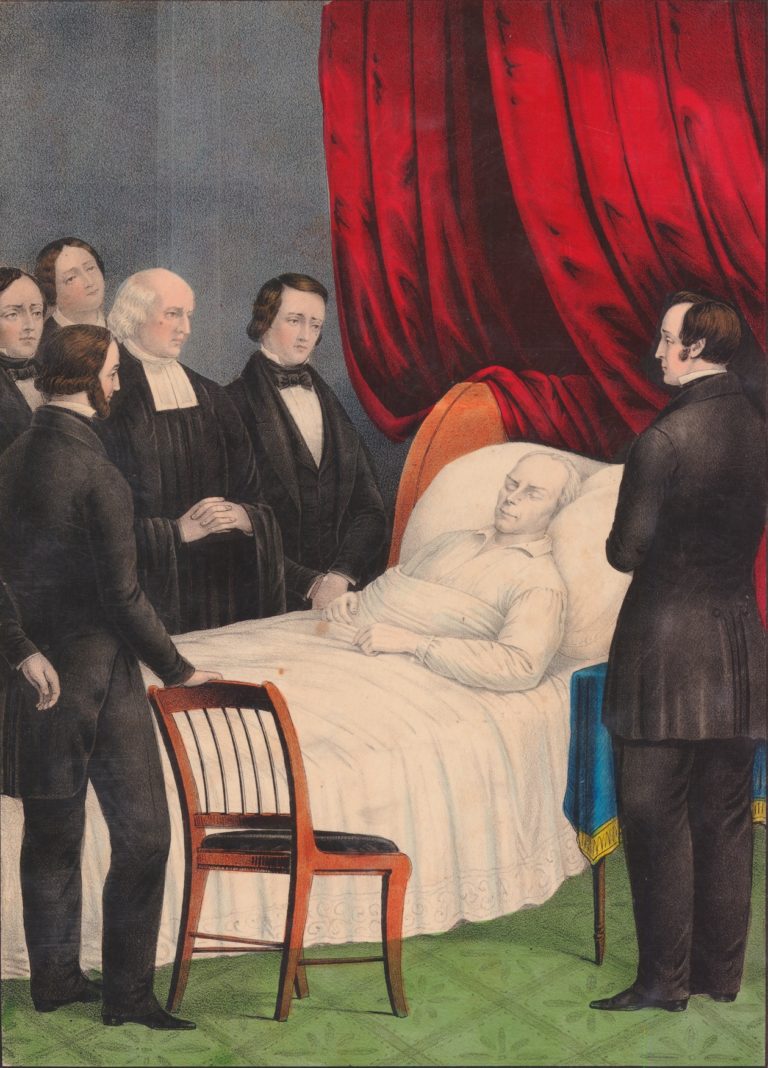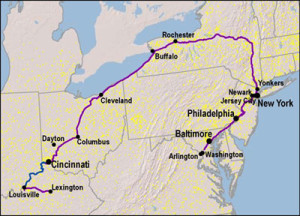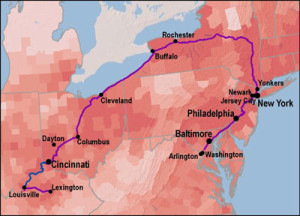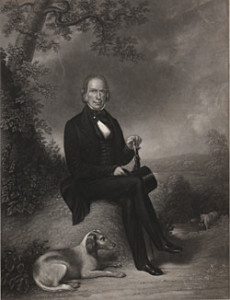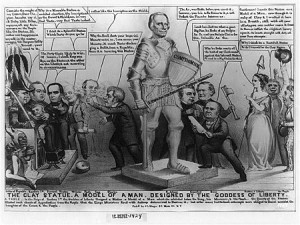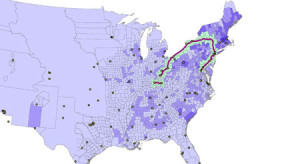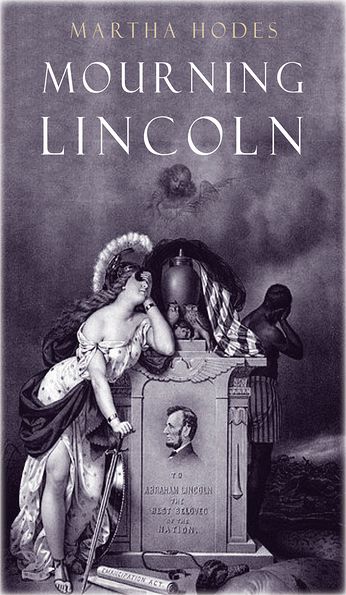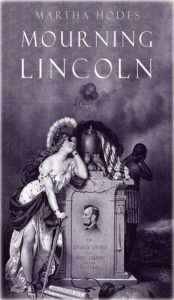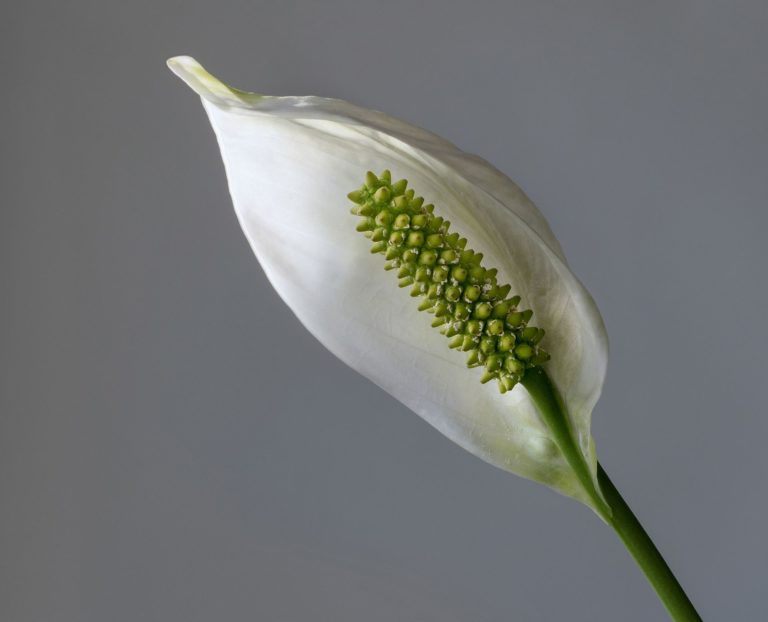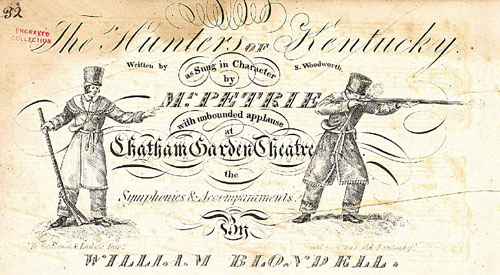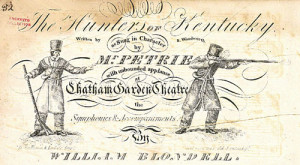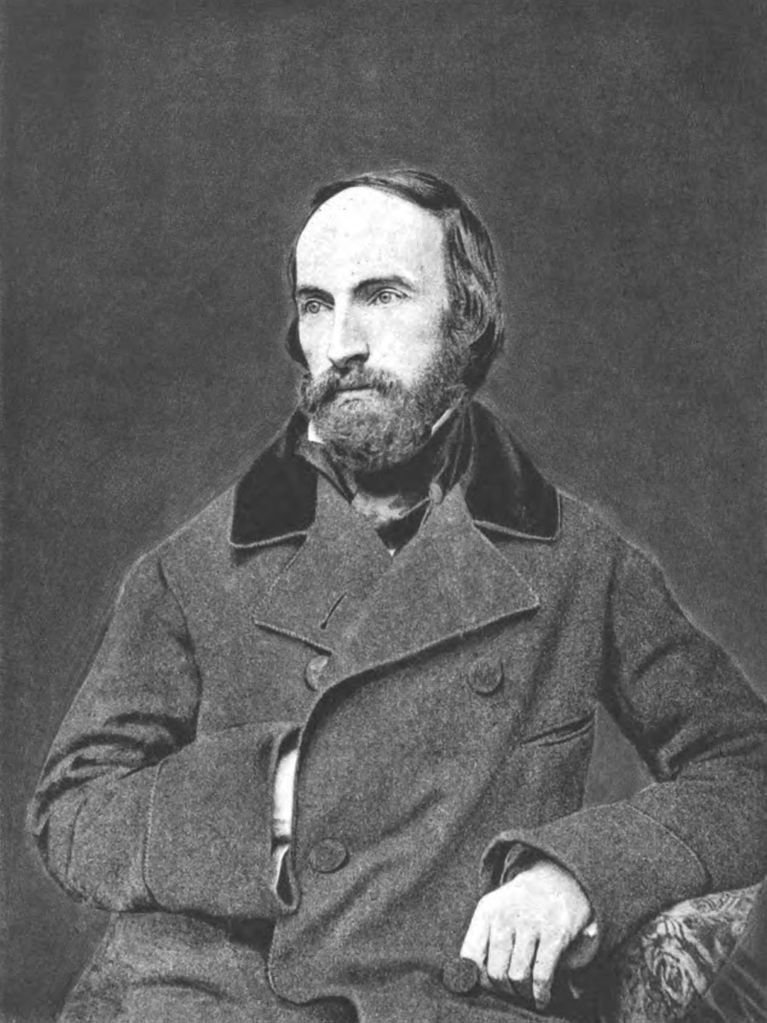Dressing for History: Teaching in Eighteenth-Century Clothing
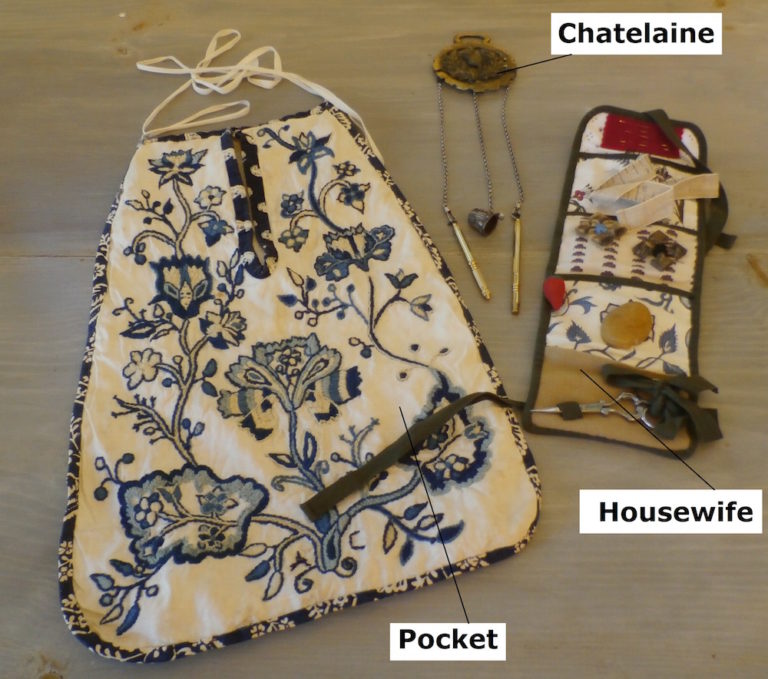
The final stages of getting ready for my work commute resemble the preparations made by most professors: car keys must be located, along with student papers, lecture notes, and the mug of tea which accompanies me into my first class of the day. But some mornings include a few more steps culminating in a dilemma not faced by anyone born in the eighteenth century, namely relearning the art of driving a car while wearing shift, stays, petticoats, and gown. The petticoats get in the way of the gas pedal, the stays require sitting perfectly straight, and the sewing tools attached to the chatelaine at my waist hit against the clutch. But all these complications are worth the response when I walk into my classroom an hour later. “Wow,” said a student the first time I taught a class in period clothing. “You really get into this” (fig. 1).
History classes often focus on political and military transitions over broad chronological periods, and discerning the social changes occurring between the decades and centuries can prove challenging for students and professors alike. My classes cover American history in the seventeenth, eighteenth, and nineteenth centuries, and flipping through a textbook or a historical film for this period easily leaves students with little more than a blur of women in long dresses and men in wool coats. And so teaching in historical clothing helps me highlight the reasons for the subtle differences between the dresses and coats, and these differences, in turn, become the story of how wider societal transitions affected the lives of ordinary people. Focusing on historical clothing conveys other benefits in the classroom. Clothing is instantly relatable. The core need for shelter from hot or cold weather and the wider desire to make a statement about how you present yourself to the world have existed for centuries, however much these statements change over time, which makes it the perfect blend of familiarity and challenge for students of all ages.
The decision to add teaching in historical clothing to my classes was a natural one for a living history interpreter turned early American history professor. I spent years working at museums across the United States, and wearing period clothing was second nature to me long before I finished my own undergraduate degree (looking back, I don’t remember telling this to any of my history professors). But teaching in a full set of period clothing requires an enormous investment, both personal and financial. At various points in my museum career, I’ve gone to the hospital in full period clothing with a head injury, purchased crickets for my sister’s lizard on my way home from work, and delighted my cat when my milk-stained apron landed on the floor in the evening. Even with all those experiences, I once hesitated to change into my eighteenth-century clothing for a night class when the one female student in the class was absent. And well-made reproduction historical clothing is expensive. Some of mine is the result of my own labor with a needle and thread; the rest was purchased by my university when items such as a gown and stays were beyond my own sewing skills. Given these challenges, while this essay is focused on teaching in historical clothing, it also suggests other methods for using historical clothing in the classroom.
I use historical clothing in both my introductory “United States History to 1877” survey class and my 300 level “Colonial America: History and Culture” class. The first class fulfills a general education requirement and is taken by many non-history majors; the second is usually taken by history majors and covers North American history from the pre-European contact period to the 1750s and is a precursor to another class on the French and Indian and Revolutionary Wars. Both classes introduce the eighteenth-century clothing during a class identified in the syllabus as a discussion on household order in colonial North America. The “U.S. to 1877” students prepare for class by reading primary source documents addressing ordinary life in the North American colonies provided by Bedford St. Martin’s America Firsthand, volume one. The “Colonial America” students read Carole Shammas’ “Anglo-American Household Government in Comparative Perspective.” While both sets of readings are used in the discussion, they also exist to suggest that the class will be no different than any other day in which students are asked to prepare for class by reading primary source documents, secondary articles, or monographs for discussion. As a side note, I find that providing students no indication in the syllabus that this class will differ from any of the others serves as a reminder that all classes can cover unexpected material.
I arrive in class on the assigned day wearing my eighteenth-century clothing, usually about five minutes before I plan to begin teaching. By that time, the first students are seated in the classroom. Sometimes there’s a sudden lull in the voices, other times the first response is immediately verbal. Students in the front rows often have questions about where my clothing came from, and I answer them informally. I begin class with a series of PowerPoint slides which introduce students to the early modern household with its complex blend of family and labor from the head of household at one end of the spectrum and servants or slaves (or both) at the other. These slides use images of historical interpreters from Colonial Williamsburg to illustrate the differences between the various social orders present in the early modern household. This exercise is easily replicated in class without historical clothing and can be further developed with Colonial Williamsburg’s “Dress the Part” activity, which is part of their larger “A Day in the Life” teaching series.
Once the class has finished discussing early modern household structures, we focus on the historical context for my own clothing. I start by explaining that men begin dressing by putting on shirts, while women wear shifts (fig. 2). Both are loosely fitted garments made from linen or cotton which can be easily washed and were intended to absorb sweat and odors from the wearer’s body. Women then put on their stays, a garment similar to the nineteenth-century corset. Most eighteenth-century stays had their lacings in the back and a smooth, conical front like this one from the Victoria and Albert Museum. Back-lacing stays must be laced by a second person, and so some stays had additional lacings in the front so they could be laced up by their wearer. I deliberately had my stays made as front-lacing stays so I could always put them on myself for class. Next, I explain to the class that while my gown may appear to be a single garment, it is composed of multiple items of clothing (fig. 3). After putting on my shift and stays, I put on my petticoats, one made from the same fabric as my gown and one made from a contrasting color. My gown is a long, open-fronted garment with sleeves, which goes on top of my shift, stays, and petticoats. Fabric was expensive before the Industrial Revolution, and open-fronted gowns helped women expand their wardrobes with relatively little fabric. Because the front part of the petticoat can be seen, wearing the petticoat made from the contrasting fabric on top of the petticoat made from the gown fabric suggests a different gown altogether. This illusion can be further enhanced with the final part of the gown, which is called the stomacher. Stomachers were triangular pieces of fabric that filled in the open part of the gown over the wearer’s waist. Most women owned several stomachers made from different fabrics, and, like the petticoats, they were used to extend their wearers’ wardrobes. While my stomacher is a simple one made from the same fabric as my gown, many were heavily embroidered and richly decorated, like this one from the Victoria and Albert Museum. Finally, I finish with my outer layers of stockings, shoes, apron, kerchief, and cap (fig. 4).
Then the two classes peel away from each other as the “United States History to 1877” class begins to focus on the ways in which clothing helps us understand historical perceptions of childhood, while the “Colonial America” class focuses on how clothing helps us understand class structures in historical societies. The initial similarities between the two classes was a deliberate decision on my part as the opening segment provides students in the “Colonial America” course who have not taken the “U.S. to 1877” course with information on early modern households necessary for taking part in the discussion, while returning students can build on previous knowledge from the earlier class and often will help lead the household order discussion. Students taking both an introductory and an upper-level course over a similar time period from the same professor will, inevitably, run into some overlap, so I use these moments to remind them of the many ways we can approach historical societies and that different lenses bring different elements to life.
Examining historical perceptions of childhood is a recurring theme throughout my “United States History to 1877” course. Like clothing, the subject of children and childhood provides students with a similar blend of familiarity and challenge to help pull them into the discussion. I introduce this theme on the first day of class by passing a reproduction of an eighteenth-century pewter porringer around the room. My porringer was given to me by my grandparents when I was born (and some students notice that the birth date is 1974 rather than 1774) but a teacher could also use an image of a pewter porringer and a modern plastic child’s bowl for a similar demonstration. While the dish travels down the first row of students, I tell them that this style of dish was often used for feeding young children and infants in the colonial period. Once the porringer has reached the second row of students, I ask why such dishes might have been used for this purpose. Some students comment that the pewter material would make it hard to break, while others notice that the handle makes it easy to hold. With the porringer entering the third row of students, I ask what it can tell us about how children were perceived in the eighteenth century. One student points out how different it is from the brightly colored plastic bowls we use for young children now; others observe that they would have no way of knowing it was a child’s dish if I had not told them, and we talk further about this.
This last point from that first day of the semester can now be more fully explored as the discussion on household order moves into its next stage. I used PowerPoint slides with photographs of historical interpreters earlier in the class to introduce them to the hierarchy present in early modern households. Now I bring up more slides to show students paintings of women and men in the seventeenth and eighteenth centuries so they can see how clothing styles changed over the course of the colonial period. I deliberately use photographs of historical interpreters earlier in the class and paintings in this part of the class to help students focus on the portraits as pictures of once living people with different ideas from our own about how they might exist and function in the world.
I next show paintings of children from the seventeenth and eighteenth centuries and ask students what they notice about the clothing. Almost immediately, someone calls out that there is almost no difference between the children’s clothing and the clothing worn by adults. I ask what this tells us about being a child in the colonial period, and conversation centers on the concept of children as miniature adults and how this affected society for both children and adults. Some classes remember the porringer from the first day of the semester, others do not, and I leave this as a connection for students to make on their own. I also show them a painting of a young boy in a dress and ask whether it is a boy or a girl, which leads to a discussion of the complications posed by changing diapers in earlier centuries and, often, a discussion on differences in how gender was perceived in the colonial period and now. Finally, we move on to the third stage of the class in which students discuss the assigned primary source documents for the day and I ask them to consider how children are portrayed in the documents. With this we round out the discussion with both visual and verbal sources on the subject.
A few weeks later, a class on the rise of the middle class in the nineteenth century returns the “United States History to 1877” class to their ongoing examination of changing perceptions of childhood. This time, I bring an American Girl doll to class that is dressed in eighteenth-century shift, stays, stockings, gown, apron, kerchief, and cap as a reminder of children’s clothing in the colonial period (fig. 5). Once the class members have again familiarized themselves with clothing for children in the eighteenth century, I exchange her clothing for a dress from the nineteenth century, with pantaloons, chemise, socks and shoes. I ask the class what they notice, and they point out the difference immediately (fig. 6). Her body is no longer carefully molded by her stays (or corset, as they were known in the nineteenth century), and her dress reaches to her knees rather than the floor. Since I do not own nineteenth-century women’s clothing, I show them drawings, which make it abundantly clear that nineteenth-century women were still wearing full-length dresses. This lesson would be equally possible with drawings of children’s clothing or a scene from a historical film.
Later in the same class, we consider differences between factory-made toys and homemade toys like these ones from the collections of Old Sturbridge Village, which raises further questions for the class. What does it mean to have a society in which children wear clothing which allows them the movement needed to play? Or a society with enough parents willing to purchase toys for their children that factory owners feel that it is financially viable to mass-produce toys? I also make the point that while working-class children now largely wore children’s styles of clothing, their daily lives included as much, or more, labor as their colonial counterparts. On the surface, this is a lighthearted conversation. After all, we are talking about clothing and toys—I did just bring a doll to my university-level classroom. But at the same time, the discussion encompasses the mass production made possible by the Industrial Revolution, Enlightenment thinkers who believed children were innocent beings who needed to be nurtured and protected, and the other massive societal shifts traditionally explored by historical survey courses.
I use the final exam for the “United States History to 1877” course to help me assess whether my students can now compare perceptions of childhood in the colonial period and the nineteenth century and also explain how these differing perceptions came to exist. One exam section asks students to pick one compare-and-contrast question from a list of four possible options; this particular question asks them to contrast “Children in the colonial period” and “Children in the Nineteenth Century” in a two- to three-paragraph essay. The last time I taught this course, there were forty-two students who took the final exam, and twelve of them chose to answer this question. All drew on a wide range of source material to support their answers, and eleven of the twelve cited changes in clothing as a core piece of evidence for their arguments (the twelfth student rarely attended class and may not have been present on the days when I used historical clothing in class). One student wrote that “in class we saw a dress that littler girls wore during the nineteenth century and it was very different from the miniature adult versions they previously wore . . . I hadn’t ever thought about it being different to be a child in the past.” Another remembered “all the layers I can still see in my head.” Overall, these responses demonstrate that historical clothing can be an effective classroom tool for exploring larger, often abstract, societal shifts and for provoking both immediate discussion and longer-term analysis and recall among students.
Unlike my “United States History to 1877” course, where historical clothing is used throughout the semester to explore shifting perceptions of childhood, my “Colonial America” class only uses historical clothing once to demonstrate class structures, though class is examined alongside racial and gender structures throughout the semester using other source material. Again, I open with the discussion on early modern households, though this time I use historical portraits rather than photographs to contrast from the “U.S. History to 1877” discussion and to move the class toward considering the lives of the people behind the pictures as quickly as possible. Once I have covered the full hierarchy of the household, I tell students that clothing was commonly used to identify class demarcations in the seventeenth and eighteenth centuries, and we focus on this point for the second part of the discussion.
My clothing represents a woman from the middling classes, and it is easily contrasted to clothing worn by women in the upper and working classes. After identifying my shift, stays, petticoats, and gown, I move on to the elements of my clothing that I did not discuss in the first class. First, I show students my linen stockings and plain black shoes, which are held together with a simple pewter buckle. Then I pass a linen stocking and a silk stocking around the room and have students feel the differences between wearing linen and silk. One of my shoes goes around the room accompanied by a shoe that I have painted to represent the embroidered silk shoes popular in the period and that has a rhinestone buckle. While the shoes travel between students, I show photographs of the original silk shoes. We talk about shoes worn simply to protect one’s feet and shoes intended to show wealth and style. Then I bring up drawings of barefoot servants and slaves on the screen and ask about field work with nothing to protect your feet from insects or rain or the stubble left behind in a harvested field. Here the conversation turns to societies in which class (and, for that matter, gender and racial) structures are immediately apparent based on appearance, and the role such a discussion plays in our own twenty-first century society. This exercise in which different stockings and shoes are passed around the room could be used in lieu of a full set of period clothing. Even passing around pieces of coarse wool and silk has much the same effect because they all demonstrate the role social class played in how clothing in the colonial period felt on the body.
I open our next discussion by asking how many students remember the nursery rhyme “Lucy Locket lost her pocket/Kitty Fisher found it/Not a penny was there in it/Only ribbon round it.” Then I ask whether any of them can lose their pockets (fig. 7). Today, this is nearly impossible with pockets sewn into clothing. But people living before the twentieth century relied on portable pockets, which could be tied around the waist. The Victoria and Albert Museum provides multiple examples of these pockets over time. I now pull out my own pocket, which measures approximately eighteen inches long, twelve inches at the base and tapering to seven inches at the top, with a slit for reaching inside. It is heavily embroidered in blue and white wool, a summer project when I was in college. It holds my housewife, a roll of fabric filled with scissors, linen tape measure, buttons, thread winders, and pins. While I pass my pocket and its contents around the room, we consider the balance between utility and decoration. If pockets do not need to be covered with embroidery to fulfill their basic purpose of holding and transporting small objects, why did middle- and upper-class women in the colonial period embroider them? And, in turn, what purpose might this labor have served?
Next, I untie my chatelaine, a brass circular disk with a thistle in the middle of the circle, which is tied to the top of my apron so it hangs at my waist (fig. 8). Three chains hang from the base of the chatelaine, one holding a stiletto, one holding a brass needle case, and one a thimble. The term chatelaine comes from medieval France, when a châtelaine was the wife of the châtelain, the lord of the manor. Initially, the châtelaine or châtelain would wear keys attached to a belt at the waist so they were both readily available and easily monitored. Over time, the term came to mean a piece of metal which held either keys or sewing tools, like this one from the Victoria and Albert Museum.
Most chatelaines were decorative and could often be very personalized. My first job as a historical interpreter was as a uniformed park ranger in the Boston Harbor Islands when I was in college. A Revolutionary War reenactment was held one weekend on the island where I worked, and I was deeply envious of the women’s clothing. One woman had a brass chatelaine with a thistle and I resolved to find one the following year when I was studying at the University of Edinburgh. Mine turned up in an antique store in North Berwick, Scotland, and I spent the next few years collecting sewing tools to hang from it. The stiletto and needle case were ordered from an American company that sells reproductions of items from the eighteenth century, but the thimble came from the Grand Bazaar in Istanbul, Turkey, and appears to have been intended for a chatelaine because there is a tiny metal loop at its base for attaching it to a chain.
Like pockets, chatelaines can be used for continuing discussions on the differences between utility and decoration. The sewing tools suspended from chatelaines all served useful purposes, and nearly all colonists would have had access to some form of these tools. But even a simple brass chatelaine like mine provides a symbol of wealth and authority. When I walk, the tools make a gentle clinking sound that can be heard across rooms and down hallways. Working-class women may have sewed, but they could not afford chatelaines, and their tools were probably not worth displaying in any event. Chatelaines can also be used to introduce new research on the lives of ordinary colonists. Marla Miller’s The Needle’s Eye: Women and Work in the Age of Revolution (2006) demonstrates that colonial society recognized clear distinctions between the simple, straight seams sewn by unskilled housewives and their daughters and the highly skilled labor done by the paid professionals who created the carefully shaped gowns and jackets worn by the middling and upper classes. The mistress of a milliner’s shop like the one recreated at Colonial Williamsburg would almost certainly have worn an elaborate chatelaine to demonstrate her professional expertise and her authority over the workers who labored beneath her. These discussions around authority and professionalism are easily linked to classes surrounding the household order discussion in my “Colonial America” course as we also consider the societal shifts demonstrated by the First Great Awakening and the transition into the Enlightenment period, which would later give birth to the American and French Revolutions at the end of the eighteenth century.
Overall, my experience with using a wide range of material objects, visual images, and written documents in the classroom suggests that all three feed the kinds of discussions that lead students into the wider pastures that help shape a class into a cohesive whole, no matter how teachers choose to use them. Nevertheless, there is another, more important, lesson to be considered here. I observed at the beginning of this essay that I did not tell any of my history professors that I spent my weekends and summers working at living history museums. I wonder now if I believed my fledgling museum career had no role in what I was learning in their classrooms. But one of my recent students concluded the final exam by writing, “I also liked when you came in with the older style clothing, not only did we learn but I admired how passionate you are towards teaching history through material culture.” I think the greatest gift we can give our students is to demonstrate the ways in which our love for history (or literature or anything else) shapes our lives inside and outside the classroom. We come to the classroom to teach our subject material, but we also provide models for how, and why, we are historians, so that our students can seek out what they, in turn, may wish to become.
Further Reading
There are many books on historical clothing and some also include instructions for making your own. I particularly recommend Norah Waugh, Corsets and Crinolines (New York, 1954), Linda Baumgarten, Eighteenth-Century Clothing at Williamsburg (Williamsburg, 1986), Beth Gilgun, Tidings from the 18th Century (Texas, 1993), Avril Hart and Susan North, Fashion in Detail from the 17th and 18th Centuries (New York, 1998), Linda Baumgarten and John Watson, Costume Close-Up (New York, 1999), Lucy Johnston, Nineteenth-Century Fashion in Detail (London, 2009) and Linda Baumgarten, What Clothes Reveal: The Language of Clothing in Colonial and Federal America (New Haven, 2012). For more information on the role played by fashion and the needle trades in the eighteenth century, I recommend Marla Miller, The Needle’s Eye: Women and Work in the Age of Revolution (Amherst, 2006), Caroline Weber, Queen of Fashion: What Marie Antoinette Wore to the Revolution (New York, 2006), Maureen Daly Groggin and Beth Fowkes Tobin, Women and the Material Culture of Needlework and Textiles, 1750-1950 (Farnham, England, 2009) and Kate Haulman, The Politics of Fashion in Eighteenth-Century America (Chapel Hill, 2011). And for more information on using historical objects in the classroom, I recommend my other article on the subject, “Teaching with a Tea Set: Using Objects in the US History Survey,” Perspectives on History 52:4 (2014).
This article originally appeared in issue 16.3 (Summer, 2016).
Abby Chandler worked at living history museums in Tennessee, Iowa, and Maryland before attending graduate school at the University of Maine. She now teaches early American history at the University of Massachusetts Lowell and her first book, Law and Sexual Misconduct in New England, 1650-1750: Steering Toward England, was published by Ashgate in 2015.









